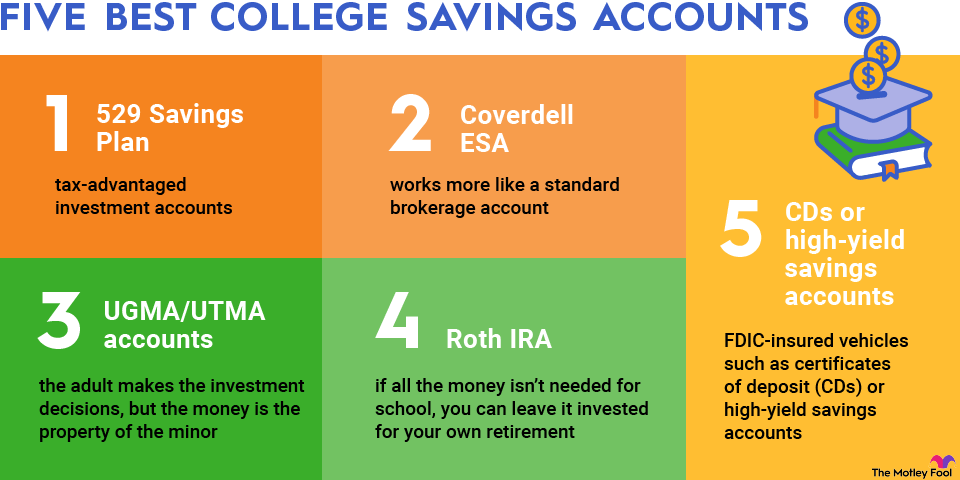There are several different ways you can choose to save for college, and the right solution for you might be one or a combination of them. Here are the five top ways to set aside money for college and what you should know about each one.

Five best college savings accounts
1. 529 savings plan
A 529 savings plan is the most popular type of college-specific investment account, and for good reason.
For one thing, 529 savings plans are tax-advantaged investment accounts. While you don’t get a federal tax deduction for contributions, your investments can grow tax-free, and any qualified withdrawals are non-taxable, regardless of how much your investments have grown.
In addition, 529 savings plans are run by the states, so depending on where you live, you might be able to get a state tax deduction for your contributions.
As far as investments go, 529 plans work like most 401(k)s. You’ll have a selection of investment funds and pre-selected portfolio options to choose from, and contribution limits are high. Most 529 plans allow you to contribute money until the account reaches $400,000 (or much more, in some cases).
The Secure Act 2.0 allows you to roll over up to $35,000 worth of 529 plans into a Roth IRA in the beneficiary's name over their lifetime if the account has been open for at least 15 years. In other words, if your child doesn't need the money for college, they could use those funds to get a head start on retirement savings.
Interest Rate
Advantages of using a CD or high-yield savings account
- Extremely safe -- virtually no risk of losing money.
- Returns can be high when interest rates rise.
- No limit to the amount of money you can contribute.
Potential drawbacks of a CD or high-yield savings account
- Low risk means low reward potential.
- Virtually no returns in low-interest environments.
- Maximizing CD yields involves keeping your money tied up.
Related investing topics
Why should you start saving for college early?
The short answer is that the earlier you start, the easier it will be. As an example, let’s assume you just had a baby, and you’d like to pay for them to go to college in 18 years. We’ll also assume that you average 7% annual returns on your investments over time and that you’d like to have $100,000 in the account by the time your child is 18.
With all of that in mind, consider these stats:
- If you start saving and investing for college when your child is born, you’d have to set aside about $245 per month to have a good chance of meeting your $100,000 savings goal.
- If you wait until your child is 5 years old, you’d need to save $413 every month to achieve the same end result.
- If you don’t start saving until your child is 10 years old, your monthly savings would need to be $812 to reasonably expect a $100,000 ending balance.
Of course, these are simplified examples, and your returns will fluctuate from year to year. But the point is that the earlier you start, the less you’ll need to save each month to put yourself in a great position to achieve your goals.
The bottom line on college savings plans
As you can see, there are several excellent options when it comes to saving for college, but the most important thing is that you come up with a solid plan and get started as soon as possible. The best account types for you depend on your goals and risk tolerance, but these five options should give you plenty to work with.
College savings accounts FAQs
Robin Hartill has no position in any of the stocks mentioned. The Motley Fool has positions in and recommends Apple. The Motley Fool has a disclosure policy.
